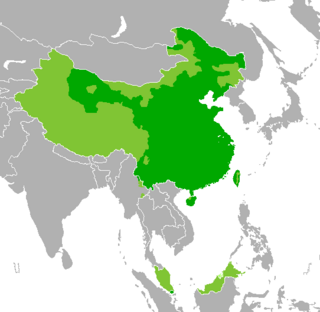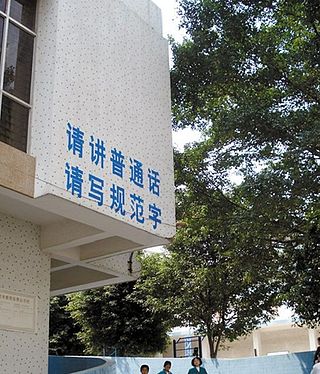
Chinese is a group of languages spoken natively by the ethnic Han Chinese majority and many minority ethnic groups in China. Approximately 1.35 billion people, or 17% of the global population, speak a variety of Chinese as their first language.

Standard Chinese is a modern standard form of Mandarin Chinese that was first codified during the republican era (1912‒1949). It is designated as the official language of mainland China and a major language in the United Nations, Singapore, and Taiwan. It is largely based on the Beijing dialect. Standard Chinese is a pluricentric language with local standards in mainland China, Taiwan and Singapore that mainly differ in their lexicon. Hong Kong written Chinese, used for formal written communication in Hong Kong and Macau, is a form of Standard Chinese that is read aloud with the Cantonese reading of characters.

Hakka forms a language group of varieties of Chinese, spoken natively by the Hakka people in parts of Southern China, Taiwan, some diaspora areas of Southeast Asia and in overseas Chinese communities around the world.

Yue is a branch of the Sinitic languages primarily spoken in Southern China, particularly in the provinces of Guangdong and Guangxi.

There are hundreds of local Chinese language varieties forming a branch of the Sino-Tibetan language family, many of which are not mutually intelligible. Variation is particularly strong in the more mountainous southeast part of mainland China. The varieties are typically classified into several groups: Mandarin, Wu, Min, Xiang, Gan, Jin, Hakka and Yue, though some varieties remain unclassified. These groups are neither clades nor individual languages defined by mutual intelligibility, but reflect common phonological developments from Middle Chinese.
A regional language is a language spoken in a region of a sovereign state, whether it be a small area, a federated state or province or some wider area.

Sinophone, which means "Chinese-speaking", typically refers to an individual who speaks at least one variety of Chinese. Academic writers often use the term Sinophone in two definitions: either specifically "Chinese-speaking populations where it is a minority language, excluding Mainland China, Hong Kong, Macau, and Taiwan" or generally "Chinese-speaking areas, including where it is an official language". Many authors use the collocation Sinophone world or Chinese-speaking world to mean the Chinese-speaking world itself or the distribution of the Chinese diaspora outside of Greater China.
Cantonese is the traditional prestige variety of Yue Chinese, a Sinitic branch of the Sino-Tibetan languages originating from the city of Guangzhou and its surrounding Pearl River Delta, with over 82.4 million native speakers.

The Hoklo people are a Han Chinese subgroup who speak Hokkien, a Southern Min language, or trace their ancestry to southeastern Fujian in China, and known by various related terms such as Banlam people, Minnan people, or more commonly in Southeast Asia as the Hokkien people. The Hokkien people are found in significant numbers in mainland China, Taiwan, Hong Kong, Macau, Singapore, Malaysia, Philippines, Indonesia, Brunei, Myanmar, and the United States,. The Hokkien people have a distinct culture and architecture, including Hokkien shrines and temples with tilted sharp eaves, high and slanted top roofs, and finely detailed decorative inlays of wood and porcelain. The Hokkien language, which includes Taiwanese Hokkien, is the mainstream Southern Min, which is partially mutually intelligible to the Teochew language, Hainanese, Leizhou Min, and Haklau Min.
The Han Chinese people can be defined into subgroups based on linguistic, cultural, ethnic, genetic, and regional features. The terminology used in Mandarin to describe the groups is: "minxi", used in mainland China or "zuqun", used in Taiwan. No Han subgroup is recognized as one of People's Republic of China's 56 official ethnic groups, in Taiwan only three subgroups, Hoklo, Hakka and Waishengren are recognized.

The Cantonese people or Yue people, are a Han Chinese subgroup originating from Guangzhou and its satellite cities and towns. In a more general sense "Cantonese people" can refer to any Han Chinese people originating from or residing in the provinces of Guangdong and Guangxi, or it may refer to the inhabitants of Guangdong province alone.

During the British colonial era, English was the sole official language until 1978. Today, the Basic Law of Hong Kong states that English and Chinese are the two official languages of Hong Kong. All roads and government signs are bilingual, and both languages are used in academia, business and the courts, as well as in most government materials today.

The languages of Taiwan consist of several varieties of languages under the families of Austronesian languages and Sino-Tibetan languages. The Formosan languages, a geographically designated branch of Austronesian languages, have been spoken by the Taiwanese indigenous peoples for thousands of years. Owing to the wide internal variety of the Formosan languages, research on historical linguistics recognizes Taiwan as the Urheimat (homeland) of the whole Austronesian languages family. In the last 400 years, several waves of Han emigrations brought several different Sinitic languages into Taiwan. These languages include Taiwanese Hokkien, Hakka, and Mandarin, which have become the major languages spoken in present-day Taiwan.

The Cantonese Wikipedia is the Cantonese-language edition of Wikipedia, run by the Wikimedia Foundation. It was started on 25 March 2006.
Singaporean Mandarin is a variety of Mandarin Chinese spoken natively in Singapore. Mandarin is one of the four official languages of Singapore along with English, Malay and Tamil.
In July 2010, the Chinese People's Political Consultative Conference (CPPCC) Guangzhou Committee, in a written proposal to mayor of Guangzhou Wan Qingliang, suggested increasing Mandarin programming on Guangzhou Television's main and news channels. The proposal sparked widespread controversy, met with fierce criticism in native Cantonese-speaking cities including Guangzhou and Hong Kong, which eventually triggered a mass protest in the former city. In a formal response, Guangzhou TV rejected the proposal, citing "historic causes and present demands" as reasons for Cantonese-Mandarin bilingualism.
Hokkien, a variety of Chinese that forms part of the Southern Min family and is spoken in Southeastern China, Taiwan and Southeast Asia, does not have a unitary standardized writing system, in comparison with the well-developed written forms of Cantonese and Standard Chinese (Mandarin). In Taiwan, a standard for Written Hokkien has been developed by the Ministry of Education including its Dictionary of Frequently-Used Taiwan Minnan, but there are a wide variety of different methods of writing in Vernacular Hokkien. Nevertheless, vernacular works written in Hokkien are still commonly seen in literature, film, performing arts and music.
The usage of Chinese by the Chinese diaspora and their descendants has been determined by a large number of factors, including their ancestry, their migrant ancestors' "regime of origin", assimilation through generational changes, and official policies of their country of residence. The general trend is that more established Chinese populations in the Western world and in many regions of Asia have Cantonese as either the dominant variety or as a common community vernacular, while Mandarin is much more prevalent among new arrivals, making it increasingly common in many Chinatowns, though still not dominant.
Malaysian Cantonese is a local variety of Cantonese spoken in Malaysia. It is the lingua franca among Chinese throughout much of the central portion of Peninsular Malaysia, being spoken in the capital Kuala Lumpur, Perak, Pahang, Selangor and Negeri Sembilan, it is also widely understood to varying degrees by many Chinese throughout the country, regardless of their ancestral language.

Protection of the varieties of Chinese refers to efforts to protect the continued existence of the varieties of Chinese in mainland China and other Sinophone regions, amid pressure to abandon their use, usually in favor of Standard Chinese. The Ministry of Education of the People's Republic of China has proclaimed to be taking active measures to protect ten varieties of Chinese. However, a large majority of the citizens of China speak a dialect of Mandarin Chinese, a standardized form of which has been enforced and promoted by the government of China for the last sixty years. The Constitution of the People's Republic of China calls on the government to promote Standard Chinese as the common tongue of the nation, but this policy has caused conflict to a certain extent with plans to preserve local varieties of Chinese. Education and media programming in varieties of Chinese other than Mandarin have been discouraged by the governments of the People's Republic of China, Singapore, and Taiwan. Teaching the varieties of Chinese to non-native speakers is discouraged by the laws of the People's Republic of China in favor of Putonghua. The Guangdong National Language Regulations were passed by the Guangdong provincial government in 2012 to promote the use of Standard Chinese in broadcast and print media at the expense of the local standard Cantonese and other related dialects. It has been labelled "pro-Mandarin, anti-Yue" legislation.












